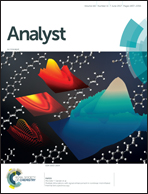Insights into chemoselectivity principles in metal oxide affinity chromatography using tailored nanocast metal oxide microspheres and mass spectrometry-based phosphoproteomics†
Abstract
The ability to comprehensively characterize biological samples, including tissues and body fluids, opens up new possibilities to diagnose and treat diseases and to better understand fundamental biological processes. For this purpose, suitable experimental workflows need to be designed. In this context, materials with particular chemoselective properties are used for the enrichment of certain classes of (bio)molecules. Metal oxides such as titanium dioxide have become the materials of choice for the large-scale study of protein phosphorylation in phosphoproteomics. Despite their widespread use, the main factors influencing their performance (for example, affinity and specificity) are not completely understood. This understanding is, however, crucial to develop improved materials and methods. Here, we used the nanocasting method to prepare microspheres of seven metal oxides with comparable textural properties, allowing an objective comparison of the materials and their binding properties. We evaluated these materials with samples of different complexity, ranging from synthetic peptides to whole cell lysates, using liquid chromatography-tandem mass spectrometry as a readout. A set of more than 7000 identified phosphopeptides allowed us to study differences between the metal oxide sorbents in detail. Importantly, the performance of the affinity materials was found to be mainly correlated with the oxides’ isoelectric points (IEPs), with the materials that enriched the highest number of phosphopeptides having an IEP of around 6. This included the widely used TiO2 and ZrO2, but also In2O3 that was not previously known to possess affinity to phosphates. This finding supports the conclusion that the IEP has a stronger influence than the particular type of metal oxide and contrasts earlier reports that compared a limited number of materials with often unknown textural properties. Taken together, we introduce new metal oxides suitable for phosphopeptide enrichment, provide deeper insight into the properties that affect their performance, and offer a strategy to optimize enrichment protocols and materials.



 Please wait while we load your content...
Please wait while we load your content...